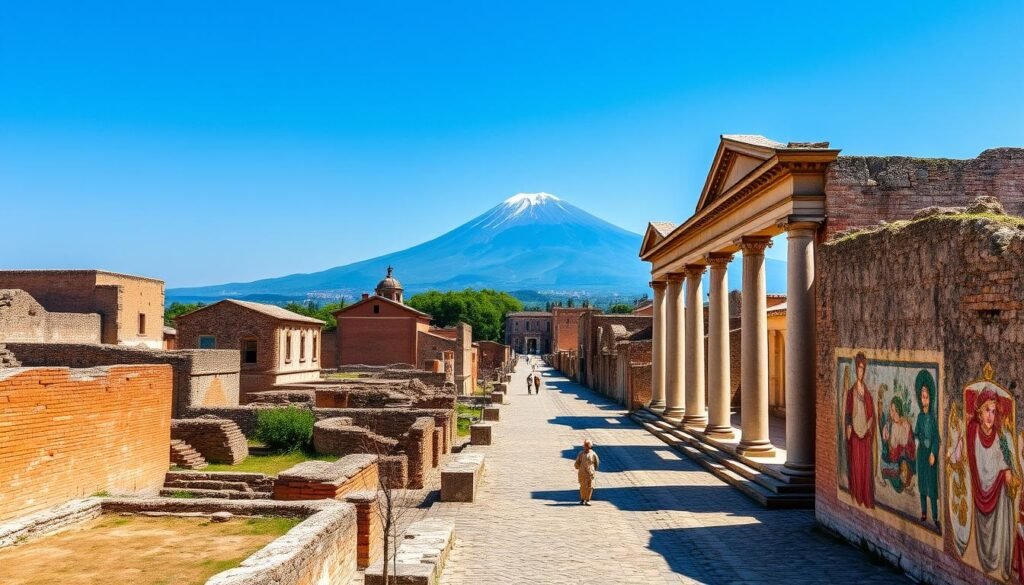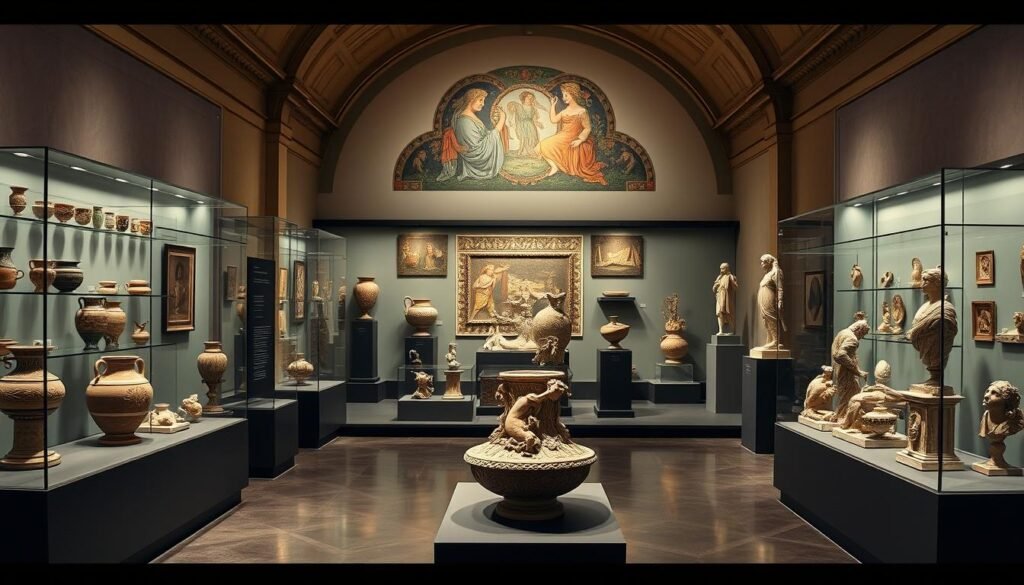Thrill of Italy | Experience Italy with authenticity.
Explore Pompeii Ancient Ruins: A Step Back in Time
Exploring the Pompeii ancient ruins is like uncovering the secrets of a lively Roman city frozen by a volcanic eruption. Picture walking through streets filled with the sounds of Roman life — from busy markets to calm public baths. This adventure starts with Pompeii tours from Rome, led by top guides who share history and explore widely.
On these tours, you’ll see the detailed buildings and items that survived Mount Vesuvius’s eruption. See the plaster casts of victims and key places like the House of the Vettii, showing the luxury of that time. The site, covering over 160 acres, tells stories of everyday life before it was stopped in 79 AD.
Your trip through this archaeological wonder gives a deep look into the past. It mixes learning with feeling deeply.


Key Takeaways
- >80-acre Pompeii site covers more ground than any other guided tour.
- Includes famous sites like the House of the Vettii and the impressive Amphitheater built in 70 BCE.
- Engage with the well-preserved bodies and plaster casts of eruption victims.
- Highly recommended, expertly guided Pompeii tours from Rome.
- Visitation yields profound insights into the Roman city and its abrupt end in 79 AD.
The Fascinating History of Pompeii
Pompeii’s history is a captivating tale of a city under Roman rule. It was a bustling place before a volcanic eruption changed everything. Let’s dive into this history, showing how ancient Romans lived in Pompeii.Before the Eruption
Pompeii had about 12,000 people, living in a city full of life. It had over 40 bakeries and 130 bars. Before the eruption, Pompeii was a key port, with grand villas and markets. People used public water sources, a common thing in Roman times. This was part of their daily life.Day-to-Day Life in Pompeii
Life in Pompeii was full of activity. The town was filled with shops, workshops, and forums. People enjoyed theater and gladiator games, typical of Roman culture. Public baths were more than just for cleaning. They were places for socializing and fun. Pompeii’s streets and buildings showed advanced planning, even without modern comforts.Impact of the Volcanic Eruption
The eruption of Vesuvius on October 24, AD 79, suddenly stopped Pompeii’s life. The eruption buried the city under 30 feet of ash, freezing time. About 2,000 people who stayed behind were trapped. The fast-moving ash flow made escape impossible. Over 2,000 bodies, including men, women, children, and animals, were found. They showed the tragic end of Pompeii’s residents. Yet, the eruption preserved Pompeii, letting us learn about Roman life.A Walk Through the Pompeii Archaeological Site
A visit to Pompeii is a journey through time. The site covers about 440,000 square meters. It would take at least three days to see everything, each piece telling a story of life long ago.
The Rediscovery of Pompeii
In the 16th century, Pompeii was rediscovered, starting a new chapter in archaeology. Excavations began in 1748 under King Charles III of Naples. They uncovered the city’s beauty and culture, thanks to ongoing preservation efforts. Walking through Pompeii, you connect with history. You see amphitheaters, public baths, and grand homes. The forum, where government and business happened, is a must-see.Current Excavations and Discoveries
Today, we focus on restoring and keeping up the site. From 1924 to 1961, Italian archaeologist Amedeo Maiuri led efforts. He preserved places like the House of the Faun and the Villa of the Mysteries. Modern research keeps uncovering Pompeii’s secrets, drawing people from all over. Pompeii is full of stories, from taverns to bakeries. The Amphitheater, built in 70 BC, is a highlight. These finds show why Pompeii is so important and why we work hard to keep its history alive. Visiting Pompeii is more than looking around; it’s an experience. It brings the past and present together. Plan your trip well to fully experience this ancient city’s wonders.Exploring the Major Attractions
As I stepped into Pompeii, the sense of history was palpable. Each structure, each relic, whispered secrets of an ancient civilization preserved in time. Let me take you through some of the key Pompeii tour attractions that bring the past vividly to life.Temple of Apollo
The Temple of Apollo is a magnificent testament to ancient Roman temples. It represents the spiritual heart of Pompeii. This temple, dating back to the 6th century B.C., was dedicated to the god Apollo. It served as a central place of worship and community congregation. Adorned with striking mosaics and sculptures, it highlights the Romans’ devotion to their deities.Amphitheater of Pompeii
No visit to Pompeii would be complete without witnessing the grandeur of the Amphitheater of Pompeii. Constructed in 70 B.C., it is the oldest surviving Roman amphitheater. With a seating capacity of 20,000, it hosted thrilling gladiatorial games and large-scale spectacles. Walking through this colossal structure, I could almost hear the echoes of the cheering crowds. It provided entertainment to the bustling city of over 20,000 residents.House of the Faun
The House of the Faun stands out in opulence and art. This enormous house, named after the bronze statue of the Dancing Faun, offers a glimpse into the luxurious lifestyles of Pompeii’s elite. The intricate mosaics that adorn the floors, including the celebrated “Alexander Mosaic,” display the peak of Roman artistry. This mansion is not merely a home but a masterpiece of ancient design. It is a testament to the opulence of the time.Thermal Baths
The thermal baths of Pompeii were more than just places for bathing; they were essential social hubs. Segregated by gender and featuring different temperatures, these baths catered to both hygiene and leisure. Romans, irrespective of their social status, frequented these baths daily. The splendid remains of the bathhouses, with their detailed decorations, are a poignant reminder of the communal and cultural significance they held in ancient Roman society. Exploring these major attractions, I felt transported back in time, experiencing the grandeur and daily life of a vibrant ancient city. Each site, from public buildings to intimate homes, interweaves to form the rich tapestry of Pompeii’s storied past.The Significance of Pompeii as a UNESCO World Heritage Site
Pompeii is known for its *cultural significance*. Being a UNESCO World Heritage Site shows its great value. The ruins give us a peek into ancient Roman life, showing us their daily routines, buildings, and society. Pompéi UNESCO World Heritage status is more than a honor. It’s a call to action for *historical conservation*. It highlights the importance of preserving sites like Pompeii, Herculaneum, and Torre Annunziata. These places show us both the strength and weakness of human societies. Pompeii covers 44 hectares and is a unique window into the past. Its excavation is unlike any other, showing us a complete Roman city. From big villas to small homes, each place tells a story of lives lost. Herculaneum, near Pompeii, offers even more insights. Its preservation is remarkable, with foods and furniture preserved under ash. Nearby, Torre Annunziata’s villas show off grand paintings and spaces for trade, revealing the wealth and commerce of ancient Rome. Pompeii’s UNESCO status highlights its *cultural significance*. It attracts scholars, historians, and artists, inspiring new discoveries and creations. Preserving Pompeii is crucial, so future generations can learn from its history.The UNESCO recognition of Pompeii, Herculaneum, and Torre Annunziata in 1997 is a lasting commitment to preserving our *historical conservation* efforts and cultural heritage.The *Pompeii UNESCO World Heritage* status is a promise to its past and future. It lets us explore history, understanding the fleeting nature of civilizations. By protecting Pompeii, we keep alive the stories of ancient times.
How to Visit Pompeii from Sorrento, Naples, or Rome
Visiting Pompeii is a journey you won’t forget. Whether you’re in Sorrento, Naples, or Rome, getting there is easy. This guide will help you plan your trip, including the best times to go and how to get there. You’ll have a great time exploring this ancient wonder.Travel Tips and Routes
Getting to Pompeii from Sorrento, Naples, or Rome is simple and fun. If you’re in Sorrento or Naples, take the Circumvesuviana train. It runs every 30 minutes and gets you to Pompeii in about 30 minutes. From Naples, it’s just a 20-minute ride. If you’re coming from Rome, take the high-speed train to Naples. It leaves every 20 minutes and takes over an hour. Then, take the local Circumvesuviana train for another 20 minutes. This way, you’ll reach Pompeii in about 2 hours. Driving? Take the A3 Pompei Ovest highway exit. Coming from Capri? Take a ferry to Sorrento, then a train or tour to Pompeii. This way, you won’t miss out on this historic site.Entrance Fees and Tours
There are many ways to explore Pompeii. Adult tickets cost €18. EU citizens aged 18-25 pay just €2. Choose from guided tours for deeper insights or self-guided tours for a relaxed pace. Each option lets you dive into Pompeii’s ancient wonders. Day passes give full access, while guided tours offer detailed stories. Both are great ways to experience Pompeii.Best Times to Visit
The best times to visit Pompeii are early morning or late afternoon to avoid crowds. Spring and autumn are the best seasons, with nice weather and fewer tourists. Spend at least 2 hours to really feel Pompeii. If you love Ancient Rome, 4-5 hours is better. This way, you can explore more deeply. By following this guide, your visit to Pompeii will be unforgettable. You’ll get to know this amazing archaeological site like never before.What to See: The Pompeii Museum
After seeing Pompeii’s ancient ruins, the Pompeii Museum is a must-visit. It offers a deeper look into the city’s past. You’ll see amazing Pompeii artifacts, including stunning ancient frescoes and sculptures.
Featured Artifacts and Exhibitions
The Pompeii Museum’s exhibits are truly impressive. You’ll see the Dionysus and Ariadne fresco and the Venus Pompeiiana and Cupid sculpture. These pieces show the artistry of ancient Pompeii. The House of the Vettii has been reopened. It shows ancient frescoes of Pompeii’s middle-class. Also, don’t miss the Battle of Alexander mosaic and scenes from the Iliad and Odyssey.The Body Casts of Pompeii
The museum has a moving display of body casts from eruption victims. The Garden of the Fugitives shows 13 Pompeiians’ last moments, found in 1961. It adds a human touch to the exploration. These casts remind us of Pompeii’s sudden end. They stand alongside the lively artifacts and frescoes. This contrast lets visitors fully experience ancient Pompeii’s life and culture.| Visiting Hours (November-March) | Visiting Hours (April-October) | Entrance Fee |
|---|---|---|
| 9:00 am to 5:00 pm | 9:00 am to 7:00 pm | €18 |
Conclusion
As I conclude this journey, Pompeii’s impact is still strong. Buried under ash for nearly 1,700 years, it now shines as a top archaeological site in Italy. Spanning 64 to 67 hectares, it was once home to 11,000 to 11,500 people. This city is remarkably preserved, giving us a peek into ancient Roman life. The rediscovery of Pompeii in the 16th century changed archaeology. Since 2018, new discoveries have kept its secrets alive. Every year, about 2.5 million people visit Pompeii. They step back in time, seeing villas, frescoes, and bakeries. It’s a glimpse of life before Mount Vesuvius’s eruption in AD 79. Exploring Pompeii, I was amazed by humanity’s strength in its ruins. It’s a UNESCO World Heritage Site, showing us what an ancient Roman city was like. Leaving Pompeii, I carry with me the stories of history, a reminder of our search for wisdom from the past.FAQ
What can I expect from a tour of the Pompeii ancient ruins?
A tour of Pompeii takes you back in time. You’ll see how Romans lived before a big eruption. You’ll see markets, baths, arenas, and fancy homes.
How can I join Pompeii tours from Rome?
Many tours from Rome are available. They include transport and guides. You’ll see the city’s main sights and learn about its history.
What was life like in Pompeii before the volcanic eruption?
Pompeii was a busy city before the eruption. It was known for trade, beautiful homes, and lively social scenes. The public baths and markets were key to daily life.
How did the volcanic eruption impact Pompeii?
The eruption of Mount Vesuvius in 79 AD buried Pompeii. This event preserved the city and its people. It gives us a rare look at ancient Roman life.
When was Pompeii rediscovered and what has been found since?
Pompeii was found again in the 16th century. Excavations have found many artifacts and buildings. They show us Roman architecture and culture.
What are some major attractions within the Pompeii archaeological site?
Must-see spots include the Temple of Apollo and the Amphitheater. Also, the House of the Faun and the thermal baths. Each place shows a different side of ancient Pompeii.
Why is Pompeii significant as a UNESCO World Heritage Site?
Pompeii’s UNESCO status highlights its cultural and historical value. It gives us a deep look into ancient Roman society. It helps in preserving and appreciating the site worldwide.
How can I travel to Pompeii from Sorrento, Naples, or Rome?
Pompeii is easy to reach by train from Sorrento and Naples. From Rome, you can take a guided tour or train. Both options are convenient.
What are the entrance fees and tour options at Pompeii?
Pompeii offers different tickets and tours. Prices vary based on the experience. Guided tours often provide more historical context.
What are the best times to visit Pompeii?
Visit Pompeii in the early morning or late afternoon for a better experience. Spring and autumn are also good times to avoid crowds.
What can I see at the Pompeii Museum?
The Pompeii Museum is a must-see. It has body casts, frescoes, sculptures, and more. Highlights include Dionysus and Ariadne, and Venus Pompeiiana and Cupid.
Source Links
- Pompeii Tour with Archaeologist Guide | Walks of Italy – https://www.walksofitaly.com/pompeii-tours/best-of-pompeii-tour/
- The Ultimate Guide to Visiting Pompeii (Updated 2024) – https://www.nomadicmatt.com/travel-blogs/visiting-pompeii/
- Exploring Pompeii: A Travelogue and Guide to Walking The Ancient City in Naples, Italy – https://www.makethemalltripsofalifetime.com/post/visiting-pompeii-walking-the-ancient-city-naples-italy
- Pompeii: Bodies, Mount Vesuvius & Herculaneum | HISTORY – https://www.history.com/topics/ancient-rome/pompeii
- Pompeii: Italy’s Frozen-in-Time Roman City – https://www.ricksteves.com/watch-read-listen/read/articles/pompeii-italy
- The Lost City of Pompeii – https://kids.nationalgeographic.com/history/article/pompeii
- Visiting the Ruins of Pompeii – https://www.visitpompeiivesuvius.com/en/e/pompeii
- Self-Guided Tour to Pompeii, Italy – https://thegenxtravels.com/2023/08/03/self-guided-tour-to-pompeii-italy/
- Wonders of Ancient Pompeii Tour – Leisure Italy – https://www.leisure-italy.com/tours/wonders-of-ancient-pompeii/
- Top 15 Things to See at Pompeii in 2024 – https://thetourguy.com/travel-blog/italy/amalfi-coast/pompeii/top-15-things-to-see-at-pompeii/
- Exploring the ruins of Pompeii | The Road to Anywhere – https://www.theroadtoanywhere.com/exploring-the-ruins-of-pompeii/
- Guide to Pompeii, Italy – https://www.pompeiitours.it/guide-to-pompeii/
- Archaeological Areas of Pompei, Herculaneum and Torre Annunziata – https://whc.unesco.org/en/list/829/
- Pompeii | History, Volcano, Map, Population, Ruins, & Facts – https://www.britannica.com/place/Pompeii
- Pompeii – an awe-inspiring UNESCO World Heritage Site | Love Our Adventures – https://www.loveouradventures.com/post/pompeii-archaeological-park
- How To Visit Pompeii From Rome – The Roman Guy – https://theromanguy.com/italy-travel-blog/pompeii/how-to-visit-pompeii-from-rome/
- Getting to Pompeii ruins, Herculaneum, and Mount Vesuvius – https://www.visitpompeiivesuvius.com/en/e/how-to-get-here
- A First-Timer’s Guide to Visiting Pompeii – https://paulpassingthrough.com/visiting-pompeii/
- Napleswise | Pompeii | How to visit the ancient ruins at Pompeii – https://napleswise.com/pompeii/our-essential-guide-for-an-incredible-visit-to-the-ancient-ruins-at-pompeii/
- How to See the Art of Pompeii at the National Archaeological Museum in Naples – https://www.artsy-traveler.com/how-to-see-the-art-of-pompeii-at-the-national-archaeological-museum-in-naples/
- Pompeii – https://en.wikipedia.org/wiki/Pompeii
- Visiting Pompeii: Explore the Ancient City of Pompeii Today! – https://www.romaexperience.com/discover-italy/visitingpompeii
